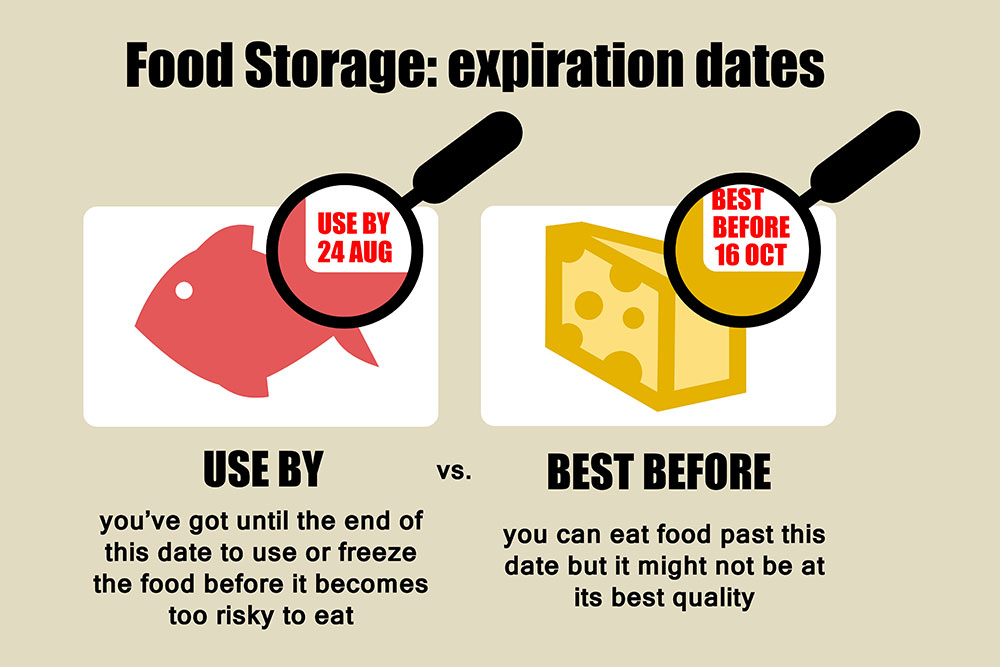
Many of us have stood in a supermarket aisle needing clarification about use-by and best-before dates. What’s the difference? When is it unsafe to eat food? Will I be ill if I eat something after one of these dates?
Food labelling, including use by and best before dates, is in place to ensure the food we consume is safe and nutritious. Everything from how the food should be cooked, prepared and stored is on the label. We clarify any confusion about these dates and explain why they’re essential.
History of Food Labelling
According to urban folklore, the infamous mobster Al Capone has something to do with food dating. How? In the 1930s, the Capone family were heavily involved in the U.S. dairy industry. A family member became sick after drinking contaminated milk, so they lobbied for dating to be placed on milk.
In the 1950s, British retailer Marks & Spencer introduced sell-by dates in their storerooms. It wasn’t until the 1970s that this labelling made it to their shop shelves. By the 1980s, many more retailers started to follow suit.
Food labelling is necessary for both the retailer and the end customer.
Retailers can order and produce appropriate levels of food items to try to eliminate food waste, which harms profits. It also ensures food is at its best and safest for its customers.
Retailers are aware of the legal repercussions involved. Under the Food Safety and Hygiene Regulations, selling or displaying food past its use-by date is criminal.
And we, the end customers, can buy foods that are still at their best and know by when to eat them.
Use By VS Best Before
Many people think use-by and best-before dates are the same. But there is definitely a difference between use-by and best-before dates. One is about safety, and the other is about quality.

Use By Date
Use-by dates are all about the safety of the food item. They indicate when food is no longer safe to eat, cook or freeze. This is regardless of how it looks and smells. Eating food after the use by dates can make you unwell.
More than 2.4 million people in the U.K. are estimated to suffer from foodborne illnesses yearly. And if you have ever experienced food poisoning, you know it’s not fun.
Foods with use-by dates are those that perish quickly. Think foods like meat, dairy and ready-to-eat salads. Food with a use-by date can be eaten up until midnight of the date on the label, but never after, unless it has been cooked or frozen.
Food can be cooked until midnight of the use-by date on the packet, then left to cool and kept in the fridge. Cooking kills any pathogens in the food, extending the time it’s safe to be eaten. But you must eat the food within 48 hours of cooking or freeze it for later.
Best Before Date
On the other hand, the best-before date indicates the quality of the food items. Food can still be eaten after the best-before date, but it may not taste its best. It will no longer be considered fresh.
You’ll see best before dates on:
- Frozen foods
- Dried foods – like rice and pasta
- Tinned foods
- Cheese
- Bread
The best-before date is a guideline. It depends on how the food item is stored. For example, food not refrigerated as instructed will go off and may be visibly inedible before the date on the label.

Sell By and Display Until Dates
The sell-by and display until dates that we see on food labelling are for retailers. It helps them with stock rotation and indicates when food needs to be removed from shelves.
Food Waste
According to the U.N. Environments Program Food Waste Index, more than 900m tonnes of food is thrown away yearly. Some 60% of this can be attributed to household food waste.
The global food system contributes to 24% of greenhouse gases too. So not only is food wasted, but it harms our environment.
You may have noticed that many foods now don’t have a date on their label. These are foods that used to display a best-before date. The reasoning behind this is to try and curb food waste. By removing the date from foods that don’t pose a safety risk, consumers are more likely to use their judgement on whether or not something is good enough to eat.
If food like fruit and vegetables is stored appropriately, it can often last longer than its best-before date. But if a date indicates that food is not at its best after a specific date, it could end up in the bin, even if it’s perfectly fine to eat.
Increase Your Knowledge of Food Safety
Food safety knowledge is essential for anyone who works with food. Producing, serving or selling food items that are safe and nutritious is, after all, the end goal. Training is a great way to ensure this. Our Level 2 Food Hygiene Course is the perfect ingredient for any business hoping to increase staff knowledge and understanding of food safety.
Our e-learning course is concise and packed with all the necessary information to start your food safety journey.
About the author(s)






















































































































































































































































































































































































































































































































































